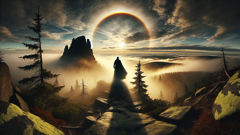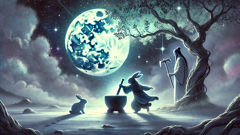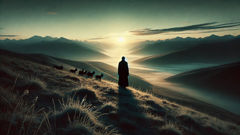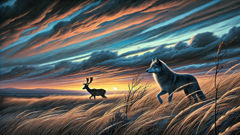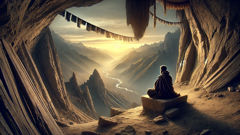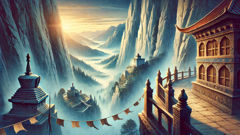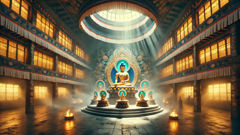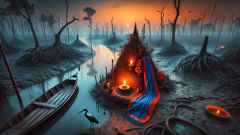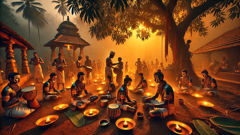Introduction
Thick mist clings to the craggy slopes of the Harz Mountains, curling through ancient spruce and beech trees like the silent breath of forgotten legends. Here, at the very heart of Germany, the Brocken rises—grim, brooding, its summit often shrouded in cloud. For centuries, wanderers and villagers alike have whispered of the Brocken Spectre: a giant, spectral figure that appears when the sun breaks through the fog, its shadow cast larger than life against the swirling gray. Some call it a warning; others claim it’s a witch’s trick, a ghostly omen for those who dare climb too high. In the villages nestled among the shadowy forests, the boundary between the natural and supernatural is thin, blurred by generations of superstition and awe. Life in these valleys follows the rhythm of seasons and the moods of the mountain itself—its howling winds in winter, the glitter of frost on pine needles, the golden haze of late summer sunsets, and, always, the ever-present possibility of the spectre’s sudden, startling appearance. The legend isn’t merely a story told by firelight. It’s a presence, as real as the moss underfoot or the distant call of a raven. It has shaped the customs of the Harz, inspiring midnight festivals, secret rituals, and whispered prayers to ward off whatever lurks in the mist. To outsiders, the phenomenon is a trick of sunlight and shadow. To those who live beneath Brocken’s gaze, it is a sign: a living reminder of the mountain’s power, the mysteries it keeps, and the fragile boundary between what can be explained—and what must simply be believed.
The Healer of Torfhaus
Agneta’s bare feet pressed into the dew-soaked moss as she climbed the mountain path at dawn. She moved quickly, hood drawn close against the chill, a basket on her arm brimming with wild herbs. Her family had served as healers in Torfhaus for three generations, entrusted with secrets passed down from mother to daughter. The villagers relied on her: for poultices against fevers, teas for childbirth, charms to soothe nightmares. But no knowledge was as vital as that which guided her steps along these mist-bound trails.
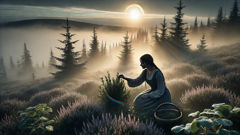
The Brocken, she’d been taught, was alive. Its moods were written in fog and wind, its warnings hidden in the sudden hush before the storm. To ignore its signs was to court disaster. Agneta’s mother had once explained, “On Brocken’s slopes, truth and shadow twist together. The mountain reveals itself to those who listen—and vanishes from those who mock it.”
That morning, Agneta’s task was urgent. Old Frau Mertens had taken ill, her breathing shallow as autumn frost, and no remedy from the valley seemed to help. Only one herb—devil’s claw—grew at the mountain’s shoulder, and only at first light. Agneta hurried through the gnarled trees, heart hammering in the silence, until the world dropped away and she stood on a ledge above a rolling sea of fog.
Here, the Brocken Spectre could appear. The villagers spoke of it with awe and dread. Some said it was the ghost of a lost traveler; others whispered that it was the mountain itself, warning intruders to turn back. Agneta had never seen it—she’d glimpsed only hints: a flicker in the mist, a prickle at her nape as if someone watched from behind. But she believed, as all wise folk did, that to see the Spectre was to be changed.
She knelt in a patch of heather, searching for the ragged leaves of devil’s claw. The silence pressed in, broken only by a distant cry of a blackbird. Suddenly, sunlight pierced the fog. Agneta glanced up—and froze. Across the swirling gray, a colossal shadow loomed. It mimicked her every move, ringed by a shimmering halo of color. Her heart pounded in terror and wonder. Was this the Brocken Spectre? Or some spirit come to test her resolve?
Breathless, Agneta stood and raised her hand. The shadow followed. She felt the weight of centuries pressing down—the stories of witches gathering on Walpurgis Night, of pacts made in darkness, of healers condemned and celebrated by turns. The Spectre wasn’t a ghost, nor a trick. It was a reminder: on this mountain, all who climbed were seen, judged, and remembered.
Walpurgis Night: Shadows and Revels
Each year, as April waned and spring threatened to overtake winter’s last grip, the villages ringing the Brocken prepared for Walpurgis Night. Tradition claimed that on this night, witches gathered at the summit to dance, feast, and consort with spirits both good and ill. Most villagers treated it as an excuse for revelry: bonfires blazed in the meadows, mead flowed freely, and children paraded in costumes meant to frighten away evil. But beneath the laughter lingered an old anxiety, sharpened by memories of past witch-hunts and whispered accusations.
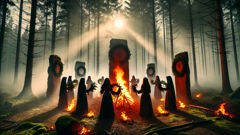
For Agneta, Walpurgis Night was sacred. She joined her mother and grandmother in the forest before dusk, each carrying a sprig of rowan and a pouch of salt. They walked in silence, weaving among ancient trees where the roots twisted like sleeping serpents. When they reached the clearing near the old standing stones, they stopped to prepare: drawing symbols on the earth with ash, scattering herbs into the fire, chanting the names of forgotten deities.
This year, Agneta felt a deeper unease. The morning’s vision haunted her. She’d seen the Brocken Spectre, but instead of fear, she’d felt recognition—a sense that the mountain had chosen her for something yet to unfold.
As darkness fell, the mist thickened, swirling around the standing stones like spectral dancers. The villagers’ laughter and music grew faint, replaced by the crackle of fire and the rhythm of ritual. Agneta’s grandmother began the chant, voice low and resonant, while Agneta traced the spiral pattern around the fire with her rowan branch.
Suddenly, the mist parted. A ring of enormous shadows appeared on the fog, each mirroring the movements of the women in the clearing. For a heartbeat, it seemed as if a gathering of giants or spirits had joined the ritual. Some villagers shrieked and fled; others knelt in awe.
Agneta watched her own magnified shadow dancing in the mist. The Brocken Spectre, summoned by firelight and faith, was neither a curse nor a blessing. It was a reflection—a living memory of those who had come before, who had called to the mountain and been answered. She raised her arms and felt the presence of her ancestors swirling around her, their shadows blending with her own.
The Witchfinder’s Fear
The legend of witches on the Brocken attracted more than villagers and curious travelers. It drew fear—and those who thrived on it. In the late spring, a stranger arrived in Torfhaus: Johann Brenner, a self-styled witchfinder from Magdeburg. He wore a black cloak, silver crucifix, and an expression sharpened by suspicion. He spoke of purifying the land, rooting out evil, and restoring order to a place he believed had lost its way.
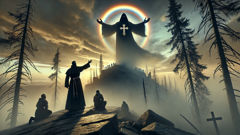
Brenner’s first act was to summon the village council. He paraded through Torfhaus with grim authority, questioning healers, midwives, and old women whose only crime was wisdom. He eyed Agneta and her family with special scrutiny, demanding explanations for their knowledge of herbs, their midnight gatherings, their role in the Walpurgis rites.
Fear rippled through the community. Some villagers, eager to deflect suspicion, whispered old grudges into Brenner’s ear. Others stood silently by, torn between respect for tradition and dread of accusation. Agneta’s mother counseled caution: “Do not provoke him. Let the mountain shield us.” But Agneta bristled at Brenner’s arrogance. She saw in him not justice but ignorance—a refusal to understand the true nature of Brocken’s mysteries.
As Brenner prowled the village, hunting for signs of witchcraft, the mountain itself seemed to respond. The weather grew unpredictable: sudden squalls of rain lashed the slopes, fog thickened into impenetrable veils, and the wind moaned through the trees like voices lost to time. The villagers grew restless, uncertain whether to fear Brenner or the mountain’s displeasure more.
One morning, Brenner decided to confront the legend directly. He led a party up the mountain, intent on exposing the “witches’ tricks” behind the Brocken Spectre. Agneta followed at a distance, heart pounding with dread and defiance. The ascent was arduous, the mist closing in until shapes and sounds became distorted.
At the summit, Brenner turned to his men and sneered, “Show me your magic.” He taunted the empty air, his voice echoing off unseen walls of cloud. But as sunlight broke through, a colossal shadow appeared on the mist—Brenner’s own form, magnified and surrounded by a spectral halo.
He staggered back in terror. His followers gasped and fell to their knees, convinced they’d witnessed a visitation from the very powers Brenner claimed to oppose. For a moment, the witchfinder was as lost as any pilgrim in the fog: humbled by his own reflection, unable to distinguish truth from legend.
Conclusion
The legend of the Brocken Spectre endures not simply because of its eerie beauty, but because it reflects something fundamental about the Harz Mountains and those who dwell beneath their watchful peaks. For Agneta and her kin, the Spectre was never a mere curiosity or an omen of doom—it was a lesson: that nature’s mysteries cannot be tamed or dismissed by fear or arrogance. The mountain’s mists conceal and reveal in equal measure, offering moments of awe for those who approach with respect. Over centuries, scientists would come to explain the Brocken Spectre as an atmospheric phenomenon—a trick of sunlight, shadow, and moisture. Yet even with knowledge comes wonder. The villagers of Torfhaus would still glance upward when fog rolled down from Brocken’s heights, searching for that sudden, towering shadow and the rainbow halo that crowned it. In every generation, children whispered about witches and mountain spirits, their stories weaving past and present into a tapestry as intricate as frost on spruce needles. The Brocken Spectre remains—part warning, part invitation—to remember that some legends are not meant to be solved, only witnessed. The mountain keeps its secrets close, offering them up in fleeting glimpses: a shadow on the fog, a thrill down the spine, and the knowledge that wonder still walks these ancient slopes.

